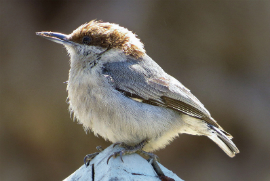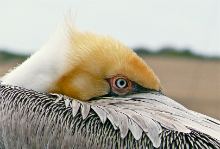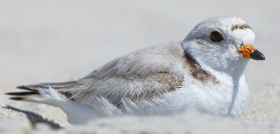Last of a two-part series
More than half of North American bird species are threatened by climate change according to a recent study by the National Audubon Society. The report, Audubon Birds and Climate, predicts that a warming climate is likely to have many species leaving home in search of cooler, more hospitable climes, including those familiar to North Carolina.
Here are some of our state’s birds that the report considers at risk of losing more than half of their current range by 2080:
Supporter Spotlight
 Audubon North Carolina is campaigning to put up 10,000 bird houses for the brown-headed nuthatch by 2015. Photo: David Hill/Flickr Creative Commons |
Brown-headed Nuthatch
The Southeastern pine-forest habitat of this squeaky-voiced bird that weighs less than one ounce is vulnerable not only to development but to the more frequent and severe storms associated with global warming, says Audubon North Carolina President Heather Hahn. There are currently only about 160,000 to 175,000 birds left in North Carolina. The birds seem content to live in manmade nest boxes if there are a few pines nearby to supply their pine-seed and insect diet. Aubudon N.C. has embarked on a massive campaign to get North Carolinians to put up nest boxes with one to 1 1/8-inch holes. Larger holes invite competing bluebirds. The goal is 10,000 boxes by the end of the year; 8,000 are already up. Find details here.
Scarlet Tanager
This flashy resident of the piedmont and mountains could find 93 percent of its winter range unsuitable by 2080. Climate-change projections show the species moving gradually north. By 2080, the only places suitable for it may be Canada and the farthest northeast points of the U.S.
Wild Turkey
North Carolina’s fields and forests echo with the “gobble, gobble” of this striking bird, brown with an iridescent sheen. Climate-change projections show wild turkey populations gradually concentrating in the mountains and further north. By 2080, their range could be greatly expanded during breeding season but not in the Carolinas, where the bird could become practically nonexistent.
How You Can HelpNational Audubon Society suggests these steps:
|
Herring Gull
Talk about a survivor. Audubon’s map page calls it “the quintessential gull: big and adaptable, lively and successful.” It’s currently snatching up fast-food leftovers in parking lots all over the East, the Midwest and the Pacific Coast; and that will continue, the report expects. There may be a thinning of its population in the Carolinas, but “with the right combination of garbage dumps, shopping malls and coastlines, herring gulls may have a better chance of weathering climate change than other species,” the report says.
Supporter Spotlight
Golden-winged Warbler
More likely to be seen in Wisconsin and Minnesota than in North Carolina, this colorful warbler nevertheless has a presence in the N.C. mountains with some 1,000 spread across a 3,000 to 6,000-foot elevation range. You can see them – if you’re persistent and lucky – on Roan Mountain, in Haywood County, and near Boone, West Jefferson, Fontana Lake and Robbinsville. They like the shrubs around the edges of mountain balds. Audubon N.C. is trying to make sure they stay in the state by advising public and private landowners on protecting their habitat. The broad range of elevation available gives them “room to move around” during climate change, says Curtis Smalling, Audubon N.C.’s director of land bird conservation.
 The brown pelican is one of 314 U.S. birds threatened by climate change. Photo: Linda Tanner/Flickr Creative Commons |
Brown Pelicans
Surfing the waves in line formation, brown pelicans are an iconic coastal bird in North Carolina. They’re found here primarily during summer breeding months and also in smaller numbers during the winter. By 2080, brown pelicans are projected to lose just over half of their current winter range. And, while the area of their suitable climatic range will expand, much of it is away from the coast. According to Audubon, one uncertainty facing the bird in coming decades is how climate change will affect its prey — fish.
American Oystercatcher
Building its nest right on the beach on the East and Gulf coasts, the comical-looking bird with the orange-ringed eyes is vulnerable to the effects that sea-level rise may have on its oyster diet but also to human efforts to hold back that rise, like dredging for beach restoration. Once a parent bird is flushed from the nest, it may abandon it. Last spring, a temporary dredging project at the south end of Wrightsville Beach — not related to climate change — took place during nesting season. Not only oystercatchers but other beach-nesting birds like least and common terns and black skimmers were “cheek by jowl with this construction project,” says Audubon biologist Lindsay Addison. “We had fewer nesting birds and less success at producing fledglings.”
Black Skimmer
The black skimmer flies so close to the surface of North Carolina’s estuaries and inlets that it appears to be skimming with the surface, its beak open, ready to scoop up dinner. Like the American Oystercatcher, the black skimmer lays its nest directly on the beach, too. Audubon dubbed this bird the “risk-takers” for putting up with coastal storms and human activities like dredging and beach re-nourishment. Soon they will risk living with sea-level rise and less coastal area suitable for survival. Audubon’s report predicts that their climatic range will decline by nearly two-thirds in the winter and by more than five-sixths in summer.
 Climate-change models predict piping plovers, a yearlong resident, will expand further north to winter. Photo courtesy: National Audubon Society |
Piping Plover
This small shorebird makes a home year-round in North Carolina. Piping Plovers are already listed on the federal Endangered Species List as threatened, in this state, and endangered, further north in their range. Audubon’s report forecasts that along the Atlantic shoreline, piping plovers will expand further north during winter. Sea-level rise will also become a critical threat to the species in both summer and winter seasons.
Dunlin
This species of sandpiper likes to visit North Carolina during the winter. Climate model predict that dunlins may have to winter further north of North Carolina as temperatures continue to warm. Unlike most of its relatives, though, dunlins aren’t accustomed to migrating great distances. Their greatest threat, however, is their disappearing summer range near the Arctic where they breed, which may simply be squeezed out by climate change, says Audubon.








